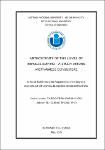| dc.description.abstract | Impulse buying is a major research concern among researchers due to its
pervasive aspects of consumer behavior as well as its mystery in the marketing world. As
counted, impulse buying has a long story of being taken into research for the past sixty
years since 1950 by Clover until the recent research paper conducted in by Chang et al. in
2011. Thus, factors affecting impulse buying have long been explored with diverse aspects,
which associate with shopping atmosphere, shopper’s personal characteristics, the various
demographic and socio-cultural features as well as product itself. However, in general
view, most of the studies on impulse purchase concentrated on the external features
impulse buying. For instance, Abratt & Goodey (1990) indicated that in-store environment
such as Point- of- Purchase (POP) posters can stimuli the impulse purchase. Next, the early
work of Rook discovered the fundamental nature of impulse buying (Rook, 1987) and later
explored the normative influences effect on it, where extrinsic impacts were highlighted
(Rook & Fisher, 1995). In 1998, Jones and Beatty continuously proposed that impulse
buying is probable to impact on individuals across circumstances. After that, Zhou &
Goong (2003) re-confirmed that impulse buying could be influenced by retail store stimuli
such as POP. Recently, the study of Chang et al. (2011) contributed some direct and
indirect influences of retail environmental traits on impulse purchase. However, most of
these researches has not brought a fully concept of impulse buying. Perhaps, they did lots
of investigation on external variables affecting impulse buying behavior while fail to
provide internal variables, which also caused impact on this consumer behavior. Besides,
results from past studies showed that the extrinsic variables did not support much to the
increasing of impulse buying of consumers. As a result, it is necessary to explore more
important internal variables which are expected to cause stronger effect on impulse buying
to provide a better understanding of the impulse buying concept and assist more
appropriate marketing decisions in the field of marketing activities. Thus, this research
paper aimed to investigate factors affecting level of impulse buying, which not only
examines new intrinsic variables influencing on impulse purchase but also check their level
of influences.
In this study, to measure the level of impulse buying of factors, a research study
was formed and presented clearly in the methodology chapter. Target populations are those
living in Ho Chi Minh City and did make impulse purchases in the past or at the time theyviii
were asked. Data was collected from 355 respondents in total by questionnaires at some
famous fashion malls in Ho Chi Minh City as well as other offline and online channels
which will be well discussed later.
The research study hypothesized five independent factors causing influences on
impulse buying, which were optimum stimulation level, hedonic purchase, consumer’s
need for uniqueness, consumer’s self-spending control as well as novelty-fashion
consciousness, however, it was found that only optimum stimulation level, hedonic
purchase and consumer’s need for uniqueness had positive impact on the level of impulse
buying while consumer’s self – spending control was pointed out having negative effect on
the dependent factor. Novelty-fashion consciousness was found to have no impact on
impulse buying as concluded by the result from data analysis.
Thus, it will be valuable for both overseas and local fashion brands/ retails to
implement the results and turn into practical marketing activities to attract more impulse
buyers. Besides, it is also useful for the researchers to develop the theoretical frameworks
and replicate in other industries.
Key words: impulse buying, impulsiveness, consumer behavior, fashion
brands, retailing, hedonic consumption, optimum stimulation, novelty-fashion
consciousness, consumer’s need for uniqueness, consumer self -spending control.
Paper type: Research paper | en_US |


